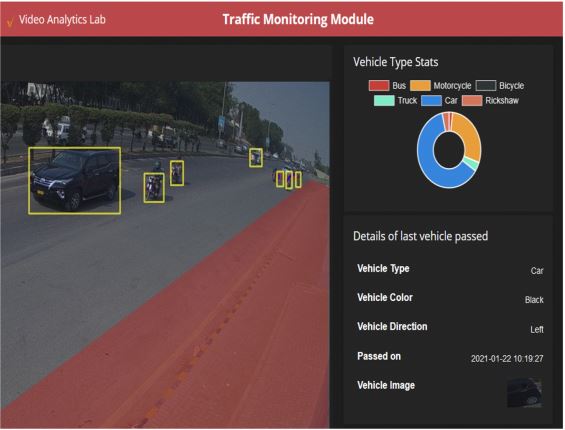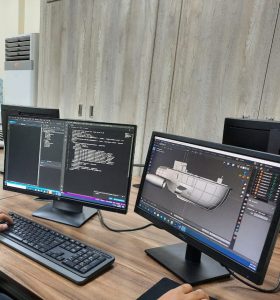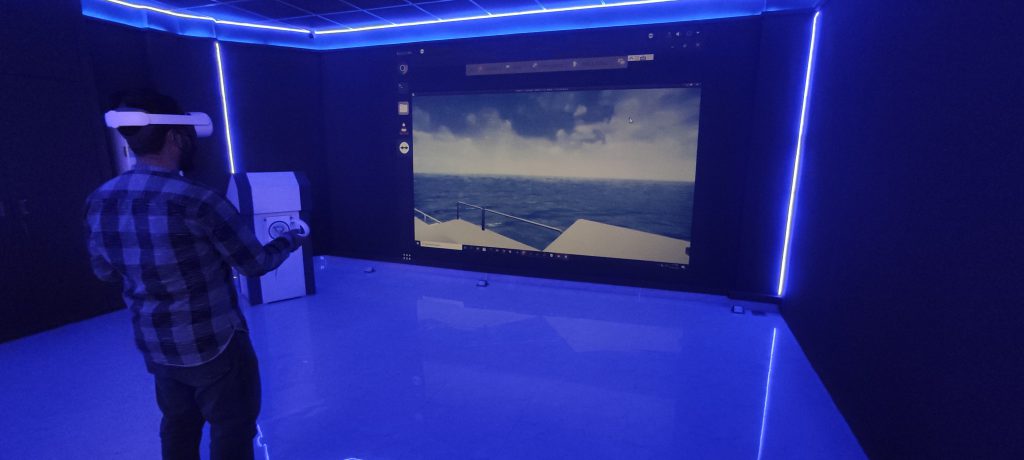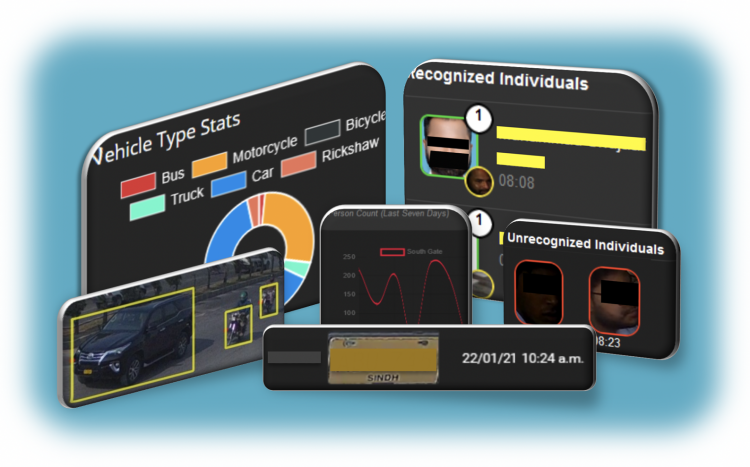1. VA Lab at PNEC-NUST established in August 2016 is focusing on providing indigenous and state-of-the-art Computer Vision- and Artificial Intelligence (AI)-based automated video content analysis solutions. The solutions are being customized to provide on-demand services as well. VA Lab is also a partner lab of National Center of Big Data and Cloud Computing (NCBC). The lab is headed by Dr Rana Hammad Raza, who is currently serving as Assistant Professor in PNEC, NUST. VA Lab has a decent team of professionals, as well as strong technical backbone with experience of timely delivered R&D projects. The lab actively offers internship and job opportunities for NUST students and graduates. As part of university research consortium, the lab has two remote research work divisions in COMSATS University Islamabad, Lahore Campus and Capital University of Science & Technology (CUST), Islamabad and are working under the co-supervision of Dr Usama Ijaz Bajwa and Dr Imtiaz Taj, respectively. The lab also has a strong backing of NUST Research Incubation Center for proper sustainability and smooth continuation of lab operations.
2. The developed VA software-based solution autonomously identifies events of interest in visual feeds. It provides a range of services such as attendance/ access control management, abandoned objects detection in restricted environments and human activities or traffic anomalies detection to prevent or control certain events. The software also provides post-event offline forensic analysis using advanced video analytics tools such as super resolution and customized video stabilization etc. Following are some highlights of VA solution:
a. Traffic Monitoring Module. Detection of region of interest in the traffic scene is a fundamental task in road monitoring and surveillance. This module includes vehicle classification, suspicious vehicle detection and vehicle counting etc.

b. Vehicle Access Control at Entry Points/ Automatic Number Plate Recognition (ANPR). This solution reads all type of Pakistan standard number plates, allows registered vehicles to pass and helps cataloguing the movements of traffic on entry and exit points.
c. Face Detection and Recognition System. The Face Detection and Recognition module includes face log, restricted entry / exit, individual localization and movement alerts etc and is being used in following sub-modules:
(1) Individual Access Control. This sub-module provides access to registered individuals inside a premise based on facial data and generates event logs. The solution can also be fused with other security infrastructure including turnstile and related access-controlled gates.

(2) Face Mask Detection for COVID-19. Following COVID-19 SOPs, the face mask detection solution uses a state-of-the-art algorithm to determine whether a person is wearing a mask or not.
d. Real-time Object Detection and Classification. Object Detection and Classification module includes detection and classification of objects from real-time scenarios in local environment. It can classify different objects in their respective categories e.g weapons, bag, laptop and cellphone etc.
e. Abandoned Objects Detection. This module allows the user to choose the area to be monitored for any kind of abandoned objects. Also, it allows the user to choose the threshold time after which the item will be listed as an abandoned object.
f. Real-time Anomalous Human Activity Detection. The Activity recognition module developed by VA Lab can classify different human actions such as fighting, pointing a gun, falling etc. This module can particularly be useful for theft detection in real-time or analysis of any activity such as sports.
3. The VA Lab also provides on-demand services for commercialization purpose. An overview of these services includes:
a. Vision-based Fire Detection. Vision-based fire detection system can detect smoke or flame at an earlier stage to save lives and assets.
b. Traffic Anomalies Detection. This includes identification of various traffic anomalies such as signal violations, lane negligence, going wrong way etc.
c. Attendance Management System. Face detection and recognition in real time can be used to mark the attendance of students or employees in near or medium field of the camera view. It can also be integrated with existing access-controlled security equipment for a two-step verification purpose.
d. Attribute-based Search. Complex tasks such as identification of a particular face in hours long multiple camera feeds can be effectively undertaken using autonomous attribute-based search.
e. Vision Super Resolution. Low resolution feeds based on certain requirement can be super resolved using state of the art algorithms.
f. Video Summary. Video digest can be generated to list major daily events and avoid cumbersome manual process.
4. VA Lab also has the capacity to work on various other Video Analytics-based offshoot areas. These areas include but are not limited to the following:
a. Maritime Traffic Monitoring for Port and Harbor Surveillance
b. Aircraft Turnaround Management for Airport Authorities
c. Support to Smart Cities w.r.t Personnel and Traffic Monitoring
5. VA Lab has published research papers w.r.t Artificial Intelligence and Computer Vision related technologies. Following are the highlights of some of the recently published research work:
a. Fine-Grained Vehicle Classification in Urban Traffic Scenes using Deep Learning. Deep learning was used to perform vehicle detection and fine-grained classification into 10 different vehicle models i.e., Suzuki Ravi, Suzuki Bolan, Suzuki Alto, Suzuki Mehran, Honda City, Suzuki Cultus, Honda Civic, Suzuki Swift, and Suzuki WagonR. This work can help in designing better traffic monitoring and management systems, especially in our local environment where the traffic is complex, urban, heterogeneous, and unsynchronized.
b. Anomaly Recognition from Surveillance Videos using 3D Convolution Neural Network. Identification of patterns and events that vary from normal stream is categorized as anomalous activity recognition. This may include abuse, fighting, road accidents, snatching, etc. This paper provides insight w.r.t identification of anomalous activities in our local environment in both real-time and offline.
c. Effectiveness of State-of-the-Art Super Resolution Algorithms in Surveillance Environment. The quality of surveillance feed is significantly degraded at times due to limitations of camera hardware, camera pose, limited bandwidth, varying illumination conditions and occlusions, resulting in compromising of sporadic information in the scene. This paper provides insight on effectiveness of some state-of-the-art Super Resolution reported algorithms for offline forensic analysis in surveillance environment.

6. Due involvement of AI in related immersive-based applications, a Virtual Reality Center (VRC) has also been established as an extension of VA Lab. VRC is a fully capacitated center which can provide scalable and cost-effective Augmented Reality (AR) and Virtual Reality (VR)-based solutions. It is being used for various operations such as:

a. Simulation-based Training for Operators
b. Design Review
c. Session-based Training
d. Maintenance Support
References:
-
S. Najeeb, R. Raza, A. Yusuf and Z. Sultan, “Fine-Grained Vehicle Classification in Urban Traffic Scenes using Deep Learning”, in 11th International Conference on Robotics, Vision, Signal Processing, and Power Applications (ROVISP), Malaysia, 05-06 Apr, 2021.
-
R. Maqsood, U. Bajwa, G. Saleem, R. Raza and M. Anwar, “Anomaly Recognition from Surveillance Videos using 3D Convolution Neural Network”, Multimedia Tools and Applications, Springer, 2021. Available: 10.1007/s11042-021-10570-3 [Accessed 12 May 2021].
-
M. Farooq, A. Khan, A. Ahmad and R. Raza, “Effectiveness of State-of-the-Art Super Resolution Algorithms in Surveillance Environment”, in 8th Machine Intelligence and Digital Interaction (MIDI) Conference, Poland (Virtual Conference), 09-10 Dec, 2020.
The author, Dr. Rana Hammad Raza is the Director of Video Analytics Lab, a partner lab of National Center of Big Data and Cloud Computing (NCBC) and Director of Virtual Reality Center. He is an Assistant Professor at Department of Electronics & Power Engineering in Pakistan Navy Engineering College (PNEC), National University of Sciences and Technology (NUST). He can be reached at [email protected].





